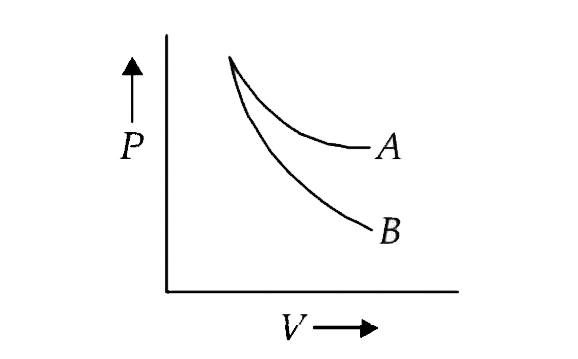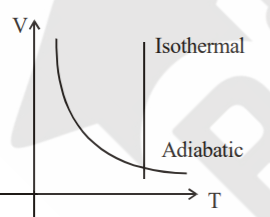Compare isothermal and an adiabatic process.
Isothermal changeAdiabatic change1. Change in volume and pressure of a gas1. Changes in volume and pressure of a gastaking place at constant temperature aretaking place in a thermally isolated systemcalled isothermal changes.are called adiabatic changes.2. Temperature of the gas remains constant.2. Temperature of the gas changes.3. The gas remains in good thermal contact3. The gas is isolated from the surroundingswith the surroundings and heat is exchanged.and heat is not exchangesΔQ=O4. Internal emergy remains constant. Change4. Internal energy changes.in internal energyΔU=O5. This process takes place slow.5. This process takes place quickly.6. Boyle.s law PV = Constant holds good6.PVr=Constant7. Workdone W=RT logeV2V17. WorkdoneW=R(r−1)(T1−T2)
Similar Questions
The curves A and B in the figure shown P-V graphs for an isothermal and an adiabatic process for an idea gas. The isothermal process is represented by the curve A.

View SolutionThe curves A and B in the figure shown P-V graphs for an isothermal and an adiabatic process for an idea gas. The isothermal process is represented by the curve A.

View Solution
Knowledge Check
Sample of gases are taken through isothermal and adiabatic process. Choose which of the following diagram correctly represent isothermal and adiabatic process
A B
B C
C D
D
The curves A and B in the figure shown P-V graphs for an isothermal and an adiabatic process for an idea gas. The isothermal process is represented by the curve A.

View Solutionanalysis OF adiabatic process, comparison OF isothermal and adiabatic process
View SolutionExplain
(i) Reversible and irreversible process
(ii) Isothermal and adiabatic process.
View SolutionThe carnot cycle of a reversible heat engine consist of
A. one isothermal and two adiabatic processes
B. Two isobaric and one adiabatic processes
C. Two isothermal and two adiabatic processes
D. Two isobraic and two isothermal processes
View SolutionDefine the following terms :
(i) System
(ii) Isothermal and adiabatic process
View SolutionIdentify isothermal and adiabatic process in the following diagram

View SolutionIsothermal Process and Adiabatic Process.
View Solution
